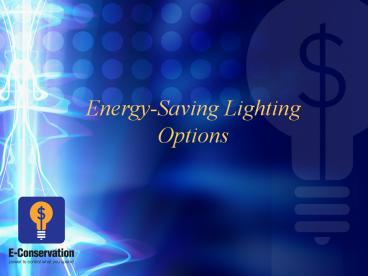Energy-Saving Lighting Options - PowerPoint PPT Presentation
1 / 18
Title:
Energy-Saving Lighting Options
Description:
Energy-Saving Lighting Options Lighting Facts Accounts for 20% to 25% of all electricity used Average household spends 5% to 10% on lighting More energy used for ... – PowerPoint PPT presentation
Number of Views:211
Avg rating:3.0/5.0
Title: Energy-Saving Lighting Options
1
Energy-Saving Lighting Options
2
Lighting Facts
- Accounts for 20 to 25 of all electricity used
- Average household spends 5 to 10 on lighting
- More energy used for lighting than to run a
refrigerator - Increasing lighting efficiency will decrease
energy bills
3
Three Types of Lighting
- Ambient Lighting
- Task Lighting
- Accent Lighting
4
Fluorescent Lighting
- Used mainly for ambient task lighting
- 3 to 4 times as efficient as incandescents
- Can last 10,000 hours
- Quite different today than in the past
- Provide a wider range of color quality
5
Fluorescent Lighting
- Work well in new or existing fixtures indoors
or outdoors - Check CFL packaging for any restrictions in use
- Some should not be used in enclosed fixtures
- Many are made for specific fixtures
6
Light Output
- Lumens measure light output
- Watts measure energy
- Example
- 100 watt incandescent 1,710 lumens
- 17 watts per lumen 17 LPW
- 29 watt CFL 1,750 lumens
- 63 watts per lumen 63 LPW
7
Light Output
8
Light Output
- Quality of CFLs is a concern for consumers
- Two factors affect lights harshness
- Color Rendering Index (CRI) measures on a scale
of 0 to 100 the perceived color of objects under
artificial light - Color Correlated Temperature (CCT) measures in
Kelvin (K) the appearance of the light itself
how warm or cool it seems
9
Color Correlated Temperature Ranges
- CFLs are available in a variety of CCT ranges
- Warm White or Soft White 2700 K 3000 K
- White, Bright White, or Medium White 3500
K - Cool White 4100 K
- Daylight 5000 K 6500 K
10
Light Output Cost Comparisons
- Some LED lighting is a less ideal replacement for
traditional lighting sources because of - Low light output
- Higher cost
- Color differences
11
Light Output Cost Comparisons
- LED lighting is a good alternative for some
lighting applications - Outdoor lighting landscaping or holiday lights
can benefit from LED durability - Longevity of LED lights is a benefit for lights
that stay on for long periods or are installed in
hard-to-reach places
12
Simple Ways to Conserve Energy Through Lighting
- Use daylight for indoor lighting
- Maintain lighting to enhance efficiency
- Turn off lights
- Clean or repaint small rooms
- Select light-colored or translucent lampshades
- Decorate with lighter colors
13
Simple Ways to Conserve Energy Through Lighting
- Place lamps in corners to reflect light
- Use dimmers, timers, motion detectors
- Replace halogen torchieres with Energy Star
torchieres - Use solar lights powered by photovoltaics
- Use task lighting
- Buy dedicated CFL fixtures
- Use low watt CFLs or an LED for nightlights
14
CFL Disposal Closing the Loop
- Mercury is an essential component of CFLs
- No mercury released from CFLs when bulbs are
intact or in use - EPA recommends taking advantage of local
recycling options for CFLs - EPA is working with CFL manufacturers major US
retailers to expand disposal options
15
Change A Light, Change the World!
- Replacing one incandescent with an Energy Star
CFL can - Save enough energy to light 7 million homes
- Would result in a total savings of 600 million
in utility bills - Replacing five most used light bulbs with Energy
Star CFLs can - Save you 60 per year in energy costs
- Result in a total savings of 8 billion per year
- Prevent greenhouse gases equivalent to emissions
from nearly 10 million cars
16
Energy-Saving Lighting Options
Compiled Deborah J. Taylor NC Cooperative
Extension Orange County Center
17
Web Resources
- Consumer Guide to Home Energy Savings
- www.aceee.org/consumerguide/lighting.htm
- Energy Star
- www.energystar.gov
- Energy Hog
- www.EnergyHog.org
- E-Conservation
- http//e-conservation.net/
18
This presentation was produced by North Carolina
Cooperative Extension, Department of 4H Youth
Development and Family and Consumer Sciences with
funding from the State Energy Office, N.C.
Department of Administration































